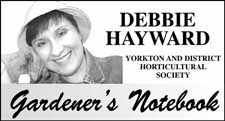Just a reminder, gardeners; the Yorkton and District Horticultural Society Spring Plant and Bulb Sale happens on Friday, May 24, from 9:30 a.m. - 5:00 p.m. at the Parkland Mall, Yorkton. There will be a great selection of plants at great prices, plus many fellow gardeners to answer your questions! But it's a one day sale! I know that some of you are looking for specific plants, so my advice to you is to be there first thing while selection is at its best! That's Friday, May 24 at the Parkland Mall.
The other day, a lovely friend told me that her daughter was interested in planting a garden in a raised bed. I was so happy that she might be trying this exciting way of gardening, and it made me want to learn more about it myself. So I got out some of my precious Sweet Pea's gardening books and started doing my homework. Here's what I learned.
Raised beds are a great idea for a number of reasons. Even if the soil in your yard is very poor, you can put good soil and compost in a raised bed, thus controlling that important factor. A raised bed will warm up sooner than your garden, enabling you to plant earlier. Raised beds drain well. Raised beds are neat and easy to keep clean. Sounds good so far, right?
So how do we make a raised bed? One of Mom's books said that we should be able to reach the raised bed from both sides, so it should be between six and eight feet wide. The raised bed should be at least twelve inches above the soil. The books suggested using wood like cedar or redwood for the frame. (It was suggested that pressure-treated wood is not the best choice for a raised bed if you are growing vegetables, so keep that in mind). Once the wooden frame is made, we should fill it with a lightweight mix of soil and compost. But I saw some photos in other gardening books, and really, the frame can be any size you want. One picture showed frames that looked to be about two feet by six feet, and there were three spaced about three feet apart, with mulch in between each. It looked very attractive. So I guess if you and I were doing this project, we could make the frames to suit our space.
Since my friend is a novice gardener, I thought I'd look up some seed suggestions for her. That great seed catalogue I told you about, "The Cook's Garden", had what they called "the new kitchen garden seed collection", so I looked through that list and picked out what is easy and delicious: onions, beets, carrots, radish, beans, squash, a row of marigolds, tomato plants, pepper plants, lettuce, and swiss chard. Even three or four tomato and pepper plants will produce more than you think, and give you a delicious harvest! There is something so special about picking veggies that you have grown yourself; they taste extra delicious! Good luck, Stephanie!
And here's some information that was shared with me: the University of Saskatchewan's GardenLine has started taking calls for this growing season. GardenLine is a free service offered through the University of Saskatchewan College of Agriculture and Bioresources to help answer gardening questions and concerns. For information or advice call 306-966-5865. While the advice is free, long-distance charges will apply. Questions can also be emailed to [email protected]. We'll chat more about this next time.
Now I'm pumped to go outside and start puttering again! As I sit here with you, the windows are open and the birds are singing up a storm: isn't spring wonderful! So good luck with your yard work, take time to sit and have a cup of tea outside when weather permits, and be sure to wear a hat! Have a good week!




